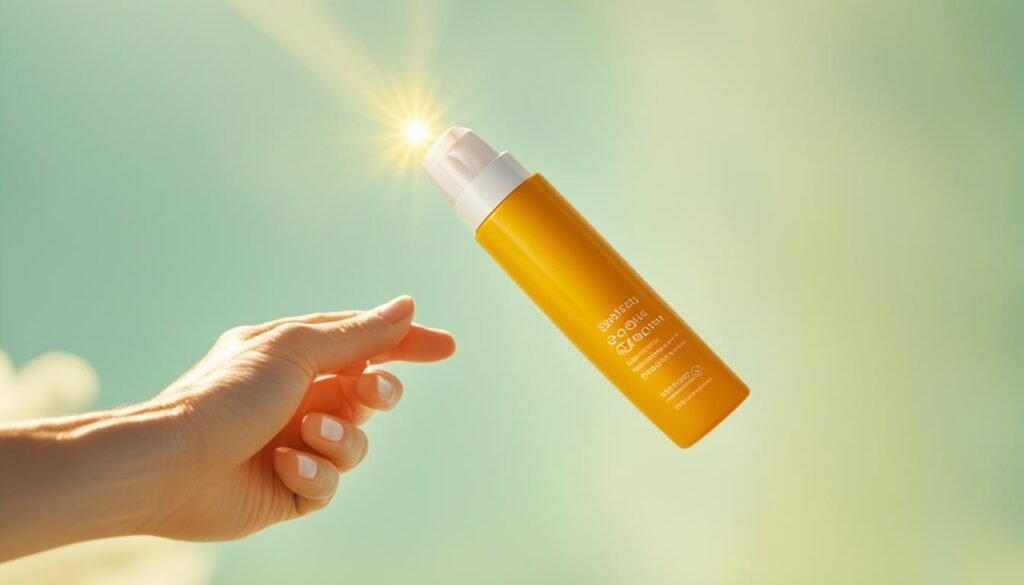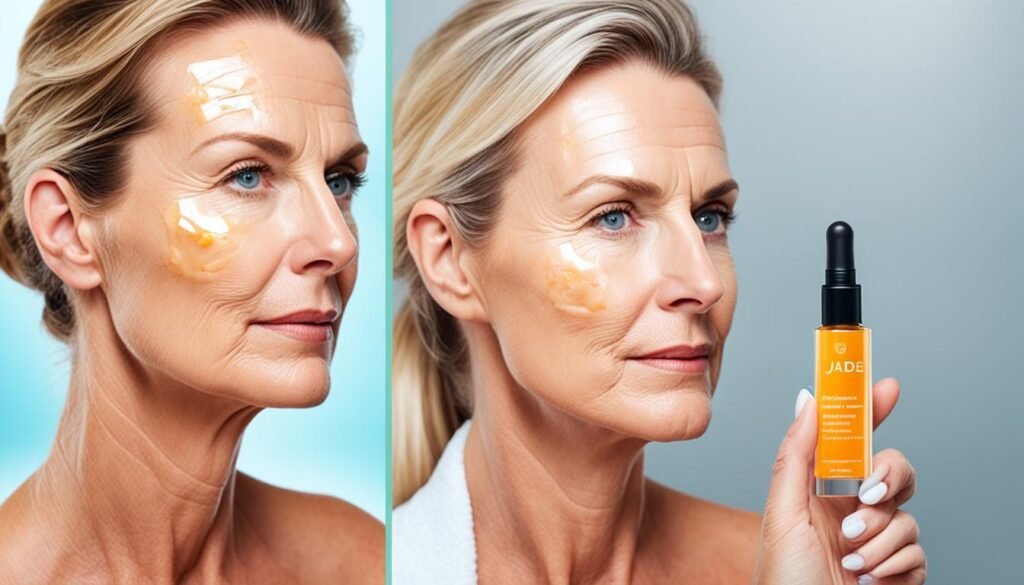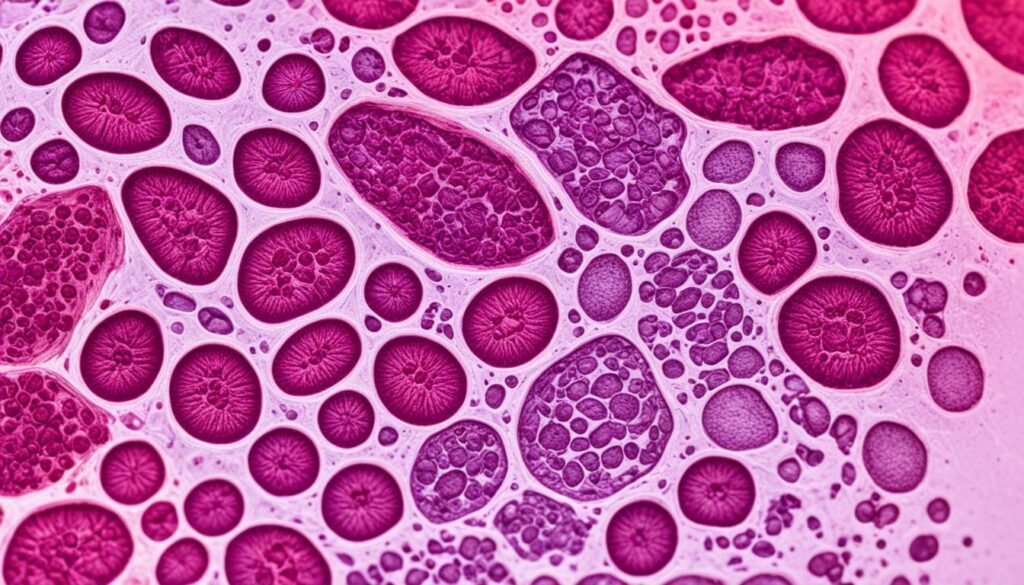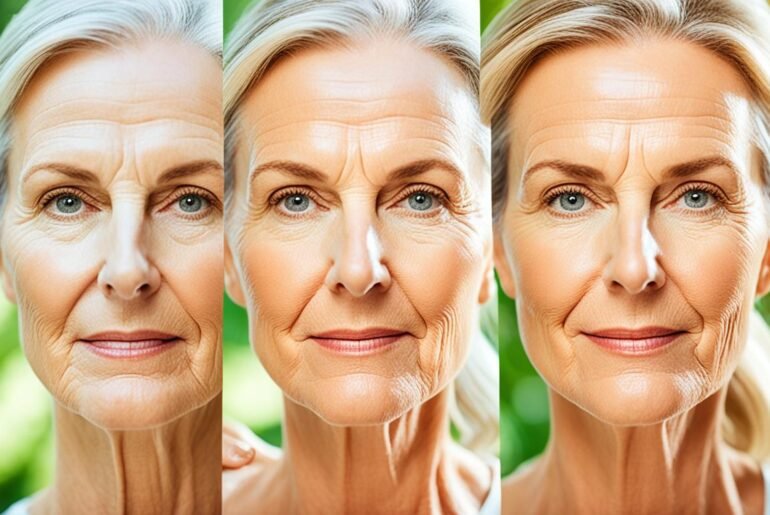Did you know that sun-damaged skin is permanent? The effects of sun damage can leave a lasting impact on your skin, causing signs of aging and increasing your risk of skin cancer. However, there are steps you can take to minimize the appearance of sun damage and protect your skin from further harm.
An anti-aging sun protection skin routine is essential for maintaining a youthful and healthy complexion. By incorporating effective skincare products and sun protection habits, you can reduce the visible signs of photoaging and safeguard your skin from the harmful effects of the sun.
Key Takeaways:
- Sun-damaged skin is permanent, but its appearance can be minimized with the right skincare products and routine.
- Photoaging, the effects of sun damage, can lead to age spots, wrinkles, and an increased risk of skin cancer.
- To protect your skin, always wear sunscreen with an SPF of at least 30 and seek shade when the sun’s rays are strongest.
- Treatments like chemical peels, lasers, and retinoids can help improve the appearance of sun-damaged skin.
- Incorporate sunscreen as a crucial step in your daily skincare routine to prevent further sun damage.
The Effects of Sun Damage on Your Skin
UV rays from the sun can penetrate the deep layers of your skin and cause sun damage, which can lead to photoaging. Sun-damaged skin refers to the skin that has been harmed by prolonged exposure to the sun’s harmful rays. This can result in various signs of photoaging that impact the appearance and health of your skin.
Some of the common signs of photoaging include:
- Age spots
- Freckles
- Loose skin
- Melasma (dark skin patches)
- Skin growths
- Spider veins
- Uneven pigmentation
- Wrinkles
Excess unprotected sun exposure over time can also increase your risk of developing skin cancer. It is crucial to take steps to protect your skin from the damaging effects of the sun.
Sun Protection Habits for Healthy Skin

To protect your skin from sun damage, it’s important to adopt sun care habits and incorporate sun protection products into your daily routine.
Wear Sunscreen with a High SPF
One of the most crucial sun protection habits is using sunscreen with a high sun protection factor (SPF). Look for a broad-spectrum sunscreen with an SPF of at least 30 to shield your skin from harmful UV rays.
Seek Shade When the Sun’s Rays are Strongest
Avoid prolonged sun exposure during the peak hours of 10 a.m. to 4 p.m. Seek shade or use umbrellas and canopies to reduce direct exposure to the sun’s intense rays.
Wear Protective Clothing
Protective clothing, such as wide-brimmed hats and long-sleeved shirts, can provide an extra layer of defense against the sun’s damaging effects. Covering up helps minimize skin exposure and reduces the risk of sunburn and photoaging.
Use Sunglasses to Protect Your Eyes
Don’t forget to shield your eyes from UV radiation by wearing sunglasses that block 100% of UVA and UVB rays. This helps prevent eye damage and reduces the risk of cataracts and other eye conditions caused by sun exposure.
Avoid Indoor Tanning
Indoor tanning beds emit harmful UV radiation, which can accelerate skin aging and increase the risk of skin cancer. Opt for safer alternatives to achieve a tan, such as self-tanning products or spray tans.
Be Mindful of Sun Exposure if You Have a Higher Risk
If you have fair skin, a family history of skin cancer, or other risk factors for sun damage, it’s essential to be extra cautious in the sun. Take additional precautions and consult with a dermatologist to develop a tailored sun protection plan.
“Protecting your skin from sun damage requires consistent sun care habits and the use of sun protection products.”
– Dr. Michelle Rodriguez, Dermatologist
Treating Sun-Damaged Skin
While sun-damaged skin is permanent, there are various treatments that can help improve its appearance. These include chemical peels, lasers, retinoids, and vitamin C serums. Let’s explore each of these treatment options:
Chemical Peels: Chemical peels involve applying a chemical solution to the skin to exfoliate and remove the damaged outer layer. This promotes the growth of new, healthier skin cells.
Lasers: Laser treatments for sun-damaged skin use concentrated beams of light to target specific areas. They can help reduce pigmentation, improve skin texture, and stimulate collagen production.
Retinoids: Retinoids are derivatives of vitamin A that are known for their ability to promote cell turnover and boost collagen production. They can help fade dark spots, reduce fine lines and wrinkles, and improve overall skin tone.
Vitamin C Serums: Vitamin C serums are packed with antioxidants that can help repair and protect the skin from further damage. They can improve skin texture, fade hyperpigmentation, and enhance overall skin radiance.
These treatments, when performed by a qualified dermatologist or skincare professional, can help reduce the signs of photoaging and improve the overall texture and appearance of sun-damaged skin.
Importance of Sunscreen in Your Skincare Routine

Dermatologists emphasize the importance of sunscreen in your skincare routine to prevent photoaging. Protecting your skin from the harmful effects of the sun requires a reliable and effective sunscreen.
When choosing a sunscreen, opt for a broad-spectrum formula that protects against both UVA and UVB rays. This ensures comprehensive coverage and defense against sun damage. Additionally, look for a sunscreen with a minimum SPF of 30 to provide adequate protection.
To properly protect your skin, it’s essential to understand proper sunscreen application. Apply sunscreen generously to all exposed areas of the skin, including the face, neck, arms, and legs. Don’t forget commonly overlooked areas such as the ears, back of the neck, and hands.
Remember to reapply sunscreen every two hours, especially if you are outdoors or engaging in activities that cause sweating. Even water-resistant sunscreens can lose their efficacy over time, so be diligent about reapplication to maintain adequate sun protection.
Sunscreen is one of the most essential products in protecting your skin from the harmful effects of the sun.
Tips for Choosing and Using Sunscreen
When it comes to protecting your skin from the harmful rays of the sun, sunscreen is a must-have in your skincare routine. Here are some tips to help you choose and use sunscreen effectively:
1. Choose a higher SPF: If you spend a lot of time outdoors, opt for a sunscreen with a higher SPF to provide maximum protection against the sun’s damaging UV rays.
2. Apply an adequate amount: To ensure sufficient coverage, apply about 1 ounce (the size of a golf ball) of sunscreen to cover your face, neck, arms, and legs. Don’t forget to apply sunscreen to often-missed areas such as the ears, back of the neck, and hands.
3. Apply before other skincare products: While the order of application may not significantly impact its effectiveness, it is generally recommended to apply sunscreen before other skincare products. This allows the sunscreen to form a protective barrier on the skin.
4. Consider mineral sunscreens for sensitive skin: If you have sensitive skin or are prone to allergies, opt for mineral sunscreens that contain ingredients like zinc oxide or titanium dioxide. These physical blockers are less likely to cause irritation.
5. Reapply regularly: Sunscreen should be reapplied every two hours or immediately after swimming, sweating, or wiping your face. This ensures that your skin remains protected throughout the day.
Remember, choosing the right sunscreen and using it correctly is vital in protecting your skin from sun damage. Make sunscreen application a daily habit and prioritize the health of your skin.
Skincare Routine for Sun-Damaged Skin

Establishing a proper skincare routine is crucial for improving the appearance of sun-damaged skin. Follow this step-by-step guide to rejuvenate and protect your skin.
Cleansing
Start your skincare routine by cleansing your face with a gentle cleanser. Look for a cleanser that is specifically formulated for sensitive or sun-damaged skin. Gently massage the cleanser onto your face using circular motions, then rinse thoroughly with lukewarm water.
Treatments and Medications
After cleansing, apply any prescribed medications or treatments that help address the effects of sun damage. This may include retinoids or vitamin C serums, which are known for their ability to improve skin texture and reduce the appearance of wrinkles and discoloration. Follow the instructions provided by your dermatologist or skincare specialist for best results.
Moisturizing
Moisturizing is an essential step in any skincare routine, particularly for sun-damaged skin. Choose a moisturizer that is lightweight and non-comedogenic to avoid clogging pores. Apply a small amount of moisturizer to your face and gently massage it into your skin using upward motions. Focus on areas that are prone to dryness or where sun damage is more noticeable.
Sunscreen
As the final step in your skincare routine, apply a broad-spectrum sunscreen with a minimum SPF of 30. This will provide protection against both UVA and UVB rays and help prevent further sun damage. Apply sunscreen evenly to all exposed areas of your skin, including your face, neck, and any other areas that are not covered by clothing. Reapply sunscreen every two hours, or more frequently if you are swimming or sweating.
Additionally, don’t forget to protect your lips from sun damage by using a lip balm with SPF.
| Skincare Routine for Sun-Damaged Skin | Brief Description |
|---|---|
| Cleansing | Use a gentle cleanser to remove impurities and prepare the skin for treatments. |
| Treatments and Medications | Apply prescribed medications or treatments to address the effects of sun damage, such as retinoids or vitamin C serums. |
| Moisturizing | Hydrate and nourish the skin with a lightweight, non-comedogenic moisturizer. |
| Sunscreen | Apply a broad-spectrum sunscreen with SPF 30 or higher to protect the skin from further sun damage. |
By following a consistent skincare routine that includes cleansing, treatments, moisturizing, and sunscreen application, you can effectively address the signs of sun damage and promote healthier, more radiant skin.
The Importance of Regular Skin Checks

Regular skin checks are crucial for the early detection of skin cancer and other concerning skin conditions. Monitoring your skin for any changes or suspicious growths can help identify potential issues before they become more serious.
During a skin check, it is important to pay attention to any moles or spots that exhibit the following characteristics:
- Changes in color: Look for moles or spots that have become darker, lighter, or unevenly pigmented.
- Changes in shape: Note any growth or distortion of the borders or size of a mole or spot.
- Changes in size: Keep an eye on any moles or spots that have significantly increased in diameter.
- Unusual symptoms: Be vigilant for moles or spots that itch, bleed, crust, or are otherwise bothersome.
If you notice any concerning changes in your skin, it is important to consult a healthcare provider for a thorough evaluation. They may perform a skin biopsy, which involves removing a small sample of tissue for examination under a microscope. This procedure can help determine if skin cancer or another skin condition is present.
Why Regular Skin Checks Matter
“Early detection is key when it comes to skin cancer. Regular skin checks can help identify any suspicious changes in your skin, allowing for timely intervention and treatment. Don’t wait until a mole or spot becomes problematic – be proactive and prioritize regular skin checks to protect your skin health.”
Conclusion
As I conclude this article, I want to highlight the importance of protecting your skin from sun damage in order to maintain a youthful and healthy complexion. Aging gracefully starts with implementing an anti-aging sun protection skin routine that includes essential steps such as regular sunscreen use, wearing protective clothing, and maintaining a consistent skincare regimen.
By making sun protection a priority in your daily life, you can minimize the effects of photoaging and reduce the risk of skin cancer. Remember to always apply a broad-spectrum sunscreen with a high SPF, seek shade during peak sun hours, wear hats and long sleeves for added protection, and use sunglasses to shield your eyes from harmful UV rays.
Additionally, don’t forget the importance of a dedicated skincare routine. Cleanse your face with a gentle cleanser, apply prescribed medications or treatments like retinoids or vitamin C serums, moisturize your skin, and, finally, apply sunscreen as the last step. Consider incorporating key ingredients like retinoids, niacinamide, and vitamin C to address the signs of photoaging.
By prioritizing the health and protection of your skin, you can maintain a youthful appearance and safeguard against sun damage. Embrace an anti-aging sun protection skin routine, and remember that prevention is key when it comes to maintaining youthful and radiant skin.
FAQ
What are the effects of sun damage on your skin?
Sun damage can lead to photoaging, which manifests as age spots, freckles, loose skin, melasma, skin growths, spider veins, uneven pigmentation, and wrinkles. Additionally, excess unprotected sun exposure can increase the risk of skin cancer.
What are some sun protection habits for maintaining healthy skin?
To protect your skin from sun damage, it is important to wear sunscreen with a high SPF, seek shade when the sun’s rays are strongest, wear protective clothing, and use sunglasses. Avoiding indoor tanning and being mindful of sun exposure is also important, especially for those at a higher risk of developing sun-damaged skin.
What treatments are available for sun-damaged skin?
Various treatments can help improve the appearance of sun-damaged skin, including chemical peels, cryosurgery, fillers, growth factors and peptides, lasers and lights, microdermabrasion, moisturizers, non-invasive radiofrequency, prescription-strength retinoids, and ultrasound.
How important is sunscreen in your skincare routine?
Sunscreen is crucial in preventing photoaging and protecting the skin from the harmful effects of the sun. Dermatologists recommend using a broad-spectrum, water-resistant sunscreen with an SPF of at least 30 daily.
What are some tips for choosing and using sunscreen?
When choosing sunscreen, opt for a product with a higher SPF if you spend a lot of time outdoors. Apply about 1 ounce of sunscreen to cover your face, neck, arms, and legs. Mineral sunscreens can be a good option for those with sensitive skin. Remember to reapply every two hours, after swimming or sweating.
What is a skincare routine for sun-damaged skin?
For sun-damaged skin, establish a skincare routine that includes cleansing with a gentle cleanser, applying prescribed medications or treatments like retinoids or vitamin C serums, moisturizing, and applying sunscreen as the final step. Consider using a lip balm with SPF for lip protection.
Why are regular skin checks important?
Regular skin checks are crucial for detecting any changes or suspicious growths that could indicate skin cancer. Monitor moles or spots that change in color, shape, size, or exhibit unusual symptoms, and consult a healthcare provider if you notice any concerning changes.




